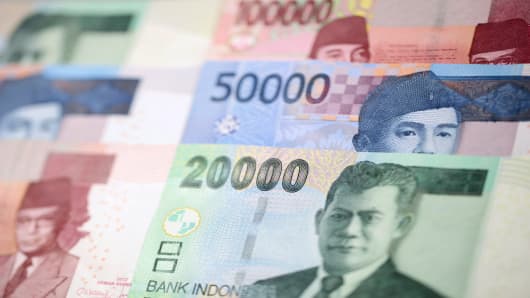Indonesia's rupiah spent the latter half of 2012 shielded from speculative strikes and volatility by the country's central bank. That veneer of stability is starting to peel, if early signs this year are anything to go by.
The currency has shed nearly 2 percent of its value against the dollar in a week, the sort of volatility last seen in mid-2012. Skittish investors, worried about the central bank's tight grip on rupiah flows and the unremitting shortage of dollars despite Bank Indonesia's routine supply to the local market, have been the main drivers of that decline.
There are other signs investors are losing faith in Bank Indonesia's ability to keep the rupiah from falling, and an auction this week of five and 10-year government bonds could be a real test of how much confidence foreigners still have.
(Read More: Weak Trade, Currency Cool Ardour for Investor Hotspot Indonesia)
Traders in Jakarta say exporters have started hoarding dollars in expectation of a drop in the currency. Foreign investors, who have stocked up on record volumes of rupiah bonds, have begun liquidating positions and driving yields up.
Future value for the rupiah has plunged in offshore forward markets, revealing a rush by foreigners to hedge their risks.
"The lack of dollar liquidity does worry us from a short-term perspective," said Paresh Upadhyaya, director of currency strategy at Pioneer Investments based in Boston. Pioneer manages $198 billion of assets globally.
"However, as long-term investors looking at the big picture we remain constructive on Indonesian assets with the expectation that the current pressure on rupiah will invite policymakers to take decisive action."
(Read More: Indonesia's Clogged Ports Strain Growth Prospects)
That action could include a rate rise that enhances the appeal of Indonesian debt for foreigners and thereby draws foreign money to bridge a record current account deficit.
Or the government could remove the fuel subsidies partly responsible for the country's rising import bill and a current account deficit that was nearly $10 billion in the fourth quarter of 2012.
The central bank's decision to leave its policy rate steady at a record low of 5.75 percent at a meeting on Thursday surprised no one, but some think it needed to make a gesture of support for the rupiah, even if solid growth and benign inflation gave them reason to stand pat.
"If the depreciation of the rupiah is excessive and lingers, we will definitely respond to it via interest rate policy," said Hartadi A. Sarwono, the deputy governor in charge of monetary policy at the central bank, after Thursday's decision.
"However, until now, we haven't seen the need."
Foreigners currently hold about $28 billion of rupiah bonds, which is a record 33 percent of local government debt. While the lure of Indonesia's high yields -- 10-year bonds have nominal yields above 5 percent -- continues to attract fund managers, not everyone wants the accompanying currency risk.
"Rupiah behavior is still rather illusive to say the least," said Woon Khien Chia, RBS's Asian rates strategist.
"We don't think our concern about the risk of a vicious cycle of weak currency, rising inflation was unfounded.
"The rupiah is still a one-way market. It's easier to get in than out," she said.
Illiquid
The rupiah was Asia's worst-performing currency against the dollar in 2012, falling 6 percent over the year.
(Read More: OECD Casts Doubt on Indonesia's High Growth Plan)
Notoriously fickle since the Asian financial crisis of 1998, the currency fell sharply in the first 7 months of the year, and then stabilized between 9,500 and 9,650 per dollar in the rest of 2012, mostly owing to Bank Indonesia's heavy management of day-to-day flows.
The main policy rate was cut once in 2012, and inflation has stayed comfortably within the central bank's target range thus far, although there is always a risk a sharply weak rupiah will stoke bigger price pressures.
The central bank even raised rates on a deposit facility it uses to mop up excess funds, or FASBI rate, in August while ensuring speculators couldn't get their hands on enough of the rupiah currency to be able to sell it aggressively.
The stock market rose 16 percent in 2012, but foreign flows at $1.6 billion fell well short of the $2.4 billion that was pumped in a year earlier.
Strategists at RBS remain wary of rupiah assets, citing high levels of pent-up dollar demand and the reduced liquidity.
"All in, it still feels like some dollar hoarding is taking place in this market by locals who are worried another tightening in onshore liquidity could suddenly haunt even the best-intentioned buy-and-holder - and even if Bank Indonesia works overtime to supply dollars to the market," they wrote in their 2013 outlook report.
Traders said the rupiah was dealt at levels of 9,850 to a dollar last week, even if official quotes showed it to be around 9,750. Ten-year yields have jumped more than 10 basis points.
"We think high demand for dollars and possible foreign selling in government bonds has been the factor on the recent move," said Leo Rinaldy, an economist at Mandiri Sekuritas.
Rinaldy reckons the rupiah will still be confined to a range between 9,800 and 9,900 in the first half of 2013, and a weakening beyond those levels would lead to losses on foreign bond portfolios and trigger heavy selling of bonds.
(Read More: Indonesia's President Reassures Investors Economy Is Top Priority)
Based on an average yield of 7.8 percent and average rupiah entry levels at 9,130 per dollar for foreigners invested in Indonesia since 2009, Rinaldy estimates the break-even for such investors would be at 9,820 rupiah per dollar.
Frances Cheung, a senior strategist at Credit Agricole CIB in Hong Kong, agreed a weaker rupiah could be a hurdle for investors who are looking for Indonesia's bonds.
"But the high yield is still attractive, so I am neutral now," she said.


